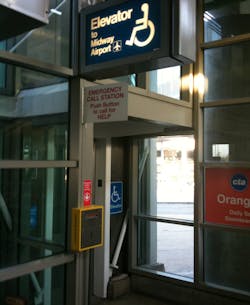With transit agencies working to grow ridership, marketing campaigns and public outreach programs to try to turn choice riders and non-riders into regular customers have been successful. But news reports of just one crime or accident can undo the savviest marketing campaign instantaneously, with unconversant riders abandoning transit due to safety concerns, which can even push away the most experienced customers.
Agencies are working to quell those concerns and pacify the system in order to keep riders safe and attract new ones. And in order to do so, they’re using all the tools they can to make sure systems are as safe as possible.
Back to basics
One of the base steps in making riders feel safer is making sure operators are properly trained to not only drive well, but to handle customer situations.
Shelly Hall, vice president of safety and security for Veolia Transportation said operators for that company undergo 120 hours of training to drive in a safe manner. It also does the “Going for Green” program to enhance customer service and make sure riders feel safe getting on board. The training is coupled with federal requirements to train operators in handling security issues, such as strange packages left on board so they can handle the situation while riders are still on board.
“From a security standpoint, we have experienced a somewhat of an increase in driver assaults and obviously that really is alarming,” Hall said. “We’re partnering with Ebert and Associates on how to mitigate assaults on our operators and again, that also deals with passenger-on-passenger situations too so they can control what’s going on in the vehicles.”
Most of the local agencies where Veolia manages also hold monthly or quarterly safety meetings with operators in order to keep them well informed about issues and Hall said another program called “Going for Care,” recently launched in order to work as a building block to the “Going for Green” program.
Hall said Veolia also beefed up its paratransit training programs as well given the significant amount of customer interaction in that service in order to make sure riders have a good experience.
Veolia plans to roll out more safety and security training programs in 2014, Hall said, to help control dangerous situations, including a training program for safety managers on how to handle a bus hijacking.
Thomas J. Harris, III, vice president of human resources and safety for First Transit & First Services, said bus operators are given 43 hours of training when they first start, including 12 hours of one-on-one time with an instructor and customer service training.
“I think that’s cornerstone,” he said. “What it does is it gives a good, strong foundation and I think everything flows and cascades from that.”
Harris said First Transit continues training sessions throughout the year and also sends out newsletters detailing incidents from across the company, so each location can learn from one another. The company also sends out DVDs to each location to educate operators by playing them on a continual loop in break rooms.
First Transit also utilizes Drive Cam with its operators so they can be reviewed when an incident occurs and further trained about things they may be doing incorrectly on their routes.
Harris said First Transit also launched a campaign in May to educate drivers on taking care of their own health as a way to address passenger safety.
“A good driver and a safe driver is also a healthy driver,” Harris said. “A safe driver worries about their personal and physical wellbeing.”
Building a safe environment
Mel Cohen, president of Handi-Hut, said strong, safe shelters can also make riders feel safer by providing them a safer environment. Handi-Hut shelters installed in New Jersey before Hurricane Sandy swept through the northeast in 2012, stood through the storm, showing they can be durable areas.
Providing all glass shelters provides safer environments and if an agency is willing to spend a few extra bucks on solar lighting it helps riders feel safer at night by lighting up an area with glass walls where people can see what’s happening inside.
Changes in designs have also made environments where riders feel safer to stand in the shelters.
“Some of the benches now are made with armrests,” he said. “So if someone is homeless they couldn’t use it as a bed.”
Marc Gagne, associate vice president of business development of rail projects for TDG Transit Design Group Inc., said safety lighting has improved in recent years with a third tier of lighting coming into rail standards where it will still work even in cases of catastrophic power loss. The standard was brought to light after the derailment of a Metrolink train in Glendale, Calif.
Gagne said a company engineer was able to meet the requirement using capacitors, noting the Soviet Army used them to start tanks in Siberia.
“I’m not saying they’re taking it more serious now, but they’re certainly taking it to a different level in the industry,” he said.
The advent of LED lighting has also helped manufacturers make the insides of rail cars or buses brighter without added power costs in recent years. Gagne said there was little innovation in the lighting world for 40 years, then about 10 years ago LEDs were able to increase options for agencies to satisfy riders.
Gagne said a railcar builder has even approached TDG about installing lighting using spectrum used to treat seasonal affective disorder inside its cars.
“They’re dubbing it the ‘happy light,’” he said. “It’s really a neat idea and something we had never thought about.”
As transit agencies have evolved in recent years, safety harnesses are also becoming more commonplace in buses.
Tony Everett, vice president of transportation solutions for HSM Solutions, said transit, commercial buses and school buses have been the last major segments of transportation to offering full restraints, which he said is “scary” given some crashes and testing done in what happens in the event of a crash.
Restrains were resisted for years because of concerns about cost, capacity loss and the small number of people who die in bus crashes per year. However, Everett said it’s a goal to get zero deaths per year and technology and designs have addressed capacity and cost issues.
“A restraint seat today is in essence cheaper — a lot cheaper — today than it was even just four years ago,” he said.
With the evolution of restraints for buses, Everett said the number of operators offering them has gone from 1 percent to 4-6 percent, with growth expected to continue annually. Three point harnesses are getting used a lot on transit applications, he said, saying it allows riders to use a restraint that’s almost as easy to use as a seat belt in a car.
Safety restraints on mass transit have an appeal to the younger generation of riders, Everett said, who are more accustomed to using seat belts in cars as opposed to older generations.
Everett said the only difficulty restraint manufacturers have to deal with is the numerous bus companies using different designs. With different flooring materials and designs it has slowed the development of harnesses, but it has significantly improved in the past 15 years.
He said HSM recently launched a new product to better accommodate young children as they ride buses as well. The portable device folds up to the size of a suitcase and can be brought onto a bus by a rider or supplied by a driver upon request in order to make sure children are properly strapped in.
A call for help is answered
David Cook, chief operating officer for Code Blue, said demand for their products continues to grow in the mass transit sector as agencies grapple with ways to protect their customers and make them feel safer. A major advantage to having emergency call units at train stations or in parking lots allows transit riders to know they can connect with police in a quick fashion without having to rely on cell phones working.
“Cell phones are a great tool to keep in touch on Facebook,” he said. “They’re a horrible tool to get help in an emergency response.”
In addition to the quick response time, Cook said the calling stations also instill confidence in riders because they can figure out how to contact someone quickly.
“They’re a no-Brainer,” he said. “It’s a big, red button.”
Alek Kireyenka, marketing manager for Talk-A-Phone, said transit agencies have asked for emergency phones inside of train vehicles, in stations and parking areas in order to give riders direct access to law enforcement in the event of an emergency. In subway lines phones are also placed along walls with blue beacons above them so rider can call in the event of a train getting stuck without worrying about getting a signal.
In recent years the company has taken things a step further with some agencies asking for phone units that can also shut down power to train tracks in the event of an emergency. Kireyenka cited a 2009 incident in Chicago where a person fell onto the tracks, but was not hurt because the train was able to be stopped.
Such units have also been put into service for light rail service in Phoenix and the Sacramento Transit Authority.
Kireyenka said transition points for transit are also becoming areas where emergency phones are requested, such as an airport or parking area, with some asking for modifications like taller light beacons so they’re not blocked by buses or other large vehicles.
“We’ve had some interesting applications in conjunction with some of our technology partners we work with as well,” he said. “In one application we’ve seen is basically taking our phones and connecting them to the wireless mesh network so that way we can build the network alongside the tracks, so our phones will be essentially hopping from one phone to the next to solve the connectivity problems. Everything is going IP and the national trend in the marketplace is going IP for telecommunications.”
In the wake of the Boston Marathon bombing, Cook said authorities learned the importance of social media and with technology used in the contact stations agencies can quell any rumors that arise on Facebook or Twitter.
“It allows them to address the public on Facebook or Twitter and calm the airs,” Cook said. “People out there are going to say all sorts of crazy stuff, but this gives ability to the property owners to set the record straight that medium.”
About the Author
Joe Petrie
Associate Editor
I came to Mass Transit in 2013 after spending seven years on the daily newsbeat in southeastern Wisconsin.
Based in Milwaukee, I worked as a daily newspaper reporter with the Waukesha Freeman from 2006-2011, where I covered education, county and state government. I went on to cover courts for Patch.com, where I was the main courts reporter in the Metro Milwaukee cluster of websites.
I’ve won multiple awards during the course of my career and have covered some of the biggest political events in the past decade and have appeared on national programs.
Having covered local government and social issues, I discovered the importance of transit and the impact it can have on communities when implemented, supported and funded.

